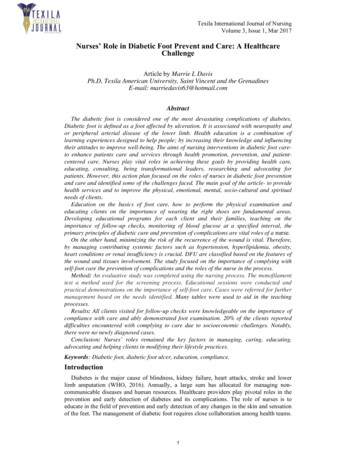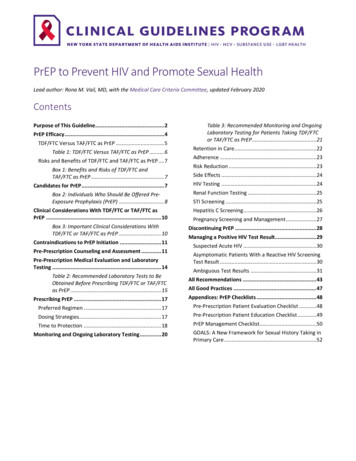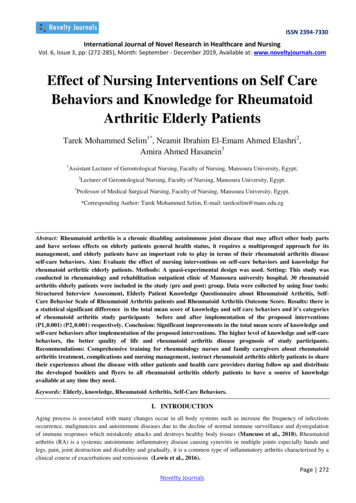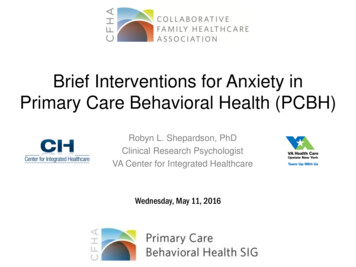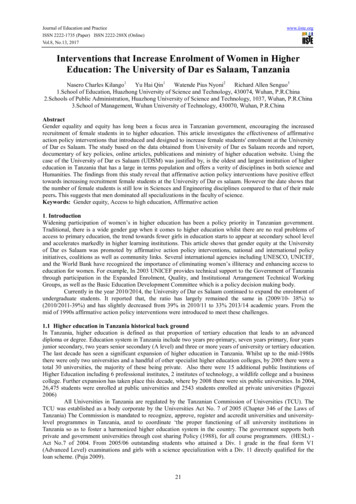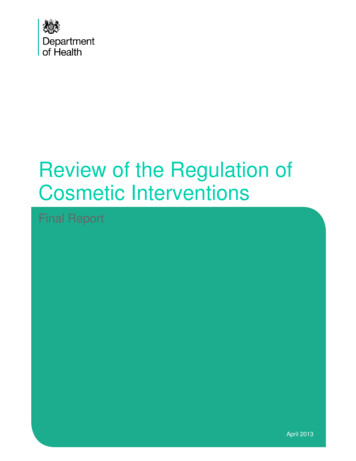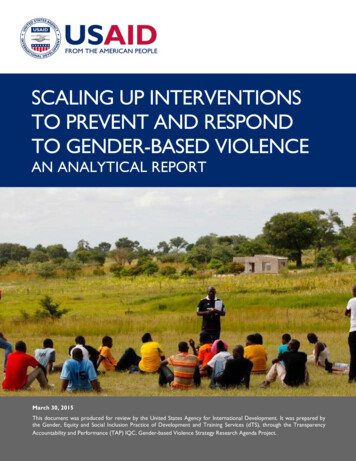
Transcription
SCALING UP INTERVENTIONSTO PREVENT AND RESPONDTO GENDER-BASED VIOLENCEAN ANALYTICAL REPORTMarch 30, 2015This document was produced for review by the United States Agency for International Development. It was prepared byithe Gender, Equity and Social Inclusion Practice of Development and Training Services (dTS), through the TransparencyAccountability and Performance (TAP) IQC, Gender-based Violence Strategy Research Agenda Project.
USAID’s Office of Gender Equality and Female Empowerment has several documents available onaddressing GBV through USAID programming that can be accessed through the DevelopmentExperience Clearinghouse (http://dec.usaid.gov).USAID Contract Number:AID-OAA-I-10-00014-TO-2-00051Scaling Up Interventions to Prevent and Respond to GBV: Analytical ReportImplemented by:Development & Training Services, Inc. (dTS)4600 North Fairfax Drive, Suite 402Arlington, VA 22203Phone: 1 703-465-9388www.onlinedts.com
ACKNOWLEDGEMENTSThis analytical report was funded by United States Agency for International Development (USAID). Itwas prepared by the Gender, Equity and Social Inclusion Practice at Development and Training Services,Inc. (dTS), and Piotr Pawlak and Neena Sachdeva, Independent Gender Consultants, through theTransparency, Accountability and Performance (TAP) IQC, Gender-based Violence Strategy ResearchAgenda Project.The authors gratefully acknowledge the support and input from USAID staff members working onselected sectors in Washington, DC, and USAID Mission and State Department staff in India and SouthAfrica. They would also like to thank the staff of non-governmental organizations (NGOs) whoparticipated in consultations and interviews. In particular, they extend their gratitude to: South Africa: Sonke Gender Justice Network in Cape Town, the Soul City Institute for Health andDevelopment Communication in Johannesburg, Medical Research Council of South Africa inPretoria, University of Witwatersrand in Johannesburg, IMAGE in Johannesburg, the Small EnterpriseFoundation (SEF) in Tzaneen, and the Khayelitsha Thuthuzela Care Center in Cape Town; India: International Center for Research on Women in New Delhi, Tata Institute for Social Sciencesin Mumbai, Committee of Resource Organizations for Literacy in Mumbai, International JusticeMission in Kolkata and Mumbai, Sanlaap, Mahima and Sari Bari in Kolkata, the United Nations Entityfor Gender Equality and the Empowerment of Women (UN WOMEN) in Mumbai; and United Kingdom: London School of Hygiene and Tropical Medicine.They also wish to thank Misrak Brhane from USAID in Washington, D.C., for her critical guidance andessential feedback on the development process of this report, and her technical and administrativesupport to Dawn Traut, Ashley Mills, Alex Ginn, Payal Chandiramani and Corey Nelson fromDevelopment and Training Services, Inc.Finally, the authors would like to express profound gratitude to all program participants, including thewomen, girls, men, and boys involved in GBV interventions, projects and research endeavors around theworld, who graciously shared their personal stories, experiences, successes and challenges with theresearch team.
SCALING UPINTERVENTIONS TOPREVENT AND RESPOND TOGENDER-BASED VIOLENCEAN ANALYTICAL REPORTDISCLAIMERThe authors’ views expressed in this publication do not necessarily reflect those of the United StatesAgency for International Development or the United States Government.
CONTENTSAcronyms . iExecutive Summary . 1Section 1: Introduction . 4Purpose of the Analytical Report . 4How to Use This Report . 5U.S. Commitment to Addressing GBV . 5Research Methodology . 6Phase 1 . 6Literature Review .6Phase 2 . 7Interviews and Focus Group Discussions (FGDs) .7Site Visits .7Limitations . 8Section 2: Scaling up Methods, Best Practices and Challenges . 11Scale-Up Methodologies Defined . 11Scaling Up through Expansion of scope .11Scaling Up through Replication .12Scaling up through Expanding Geographic Coverage .12Considerations in Scale-Up . 13Best Practices in Scaling Up . 13Barriers to Scaling Up . 14Theory to Practice . 15Section 3: Lessons Learned from Scaled-Up GBV interventions . 19Lesson I: Align Interventions with National Commitments to End GBV . 21Case Study: The One Man CAN (OMC) Campaign .21Lesson 2: Secure Community Ownership for the GBV Intervention . 24Case Study: Program H to Yaari Dosti .25Lesson 3: Provide Proof of Concept for the GBV Intervention . 27Case Study: Intervention with Microfinace for AIDS and Gender Equity .29Lesson 4: Build a GBV Community of Practice. 32Case Study: Stepping Stones .32Lesson 5: Integrate GBV into Government Structures and Sectoral Programming . 34Case Study: Combatting Commerical Sexual Exploitation (CCSE) .35Case Study: The Thuthuleza Care Centers .38Lesson 6: Design the GBV Intervention with Scale in Mind . 40Case Study: Soul City Institute for Health and Development Communication (IHDC) .41
Section 4: Key Lessons and Applying Lessons Learned . 46Key Findings . 46Alternatives to Scaling up.46Assessing and Designing for Scale-Up .47Annex A: GBV Scalability Checklist Tool . 48Annex B: Key Stakeholder Guide . 51Annex C: Key Stakeholder Interviews . 52Annex D: Promundo Program H Replications . 57Annex E: Sector Lessons . 58Annex F: Resource Guide . 62
ACRONYMSCBOCommunity–Based OrganizationCCSECombating Commercial Sexual ExploitationCOROCommittee of Resources Organization for LiteracyFGM/CFemale Genital Mutilation/CuttingGBVGender-Based ViolenceGEGender EqualityGEMSGender Equality Movement in SchoolsHIV/AIDSHuman Immunodeficiency Virus/Acquired Immune Deficiency SyndromeHTPHarmful Traditional PracticesIJMInternational Justice MissionIMAGEIntervention with Microfinance for AIDS and Gender EquityICRWInternational Center for Research on WomenIPVIntimate Partner ViolenceLGBTILesbian, Gay, Bisexual, Transgender, and IntersexMAMTAHealth Institute for Mother and ChildMATIMenEngage Africa Training InitiativeMFLMicro Finance LoansMOUMemorandum of UnderstandingMSIManagement Systems InternationalN.D.Not datedNGONon-Governmental OrganizationNNVAWNational Network on Violence against WomenNPANational Prosecuting AuthorityOMCOne Man Can CampaignOSCOne Stop CentersPEPPost-Exposure ProphylaxisPPSAPlanned Parenthood of South AfricaRADARRural Aids and Development Action ResearchRCTRandomized Control TrialSAGSouth Africa GovernmentSCIDHCThe Soul City Institute for Health and Development CommunicationSC4Soul City SeriesSEFSmall Enterprise FoundationSFLSisters for Lifei
SOCASexual Offences and Community AffairsSONKESonke Gender Justice NetworkSTIsSexually Transmitted InfectionsTISSTATA Institute for Social SciencesTCCThuthuleza Care CenterUNFPAUnited Nations Population FundUSAIDUnited States Agency for International DevelopmentUSGUnited States GovernmentVCTVoluntary Counseling and TestingWHOWorld Health OrganizationWJEIWomen’s Justice and Empowerment Initiativeii
EXECUTIVE SUMMARYThis report on scaling up interventions to prevent and respond to GBV was commissioned by theUnited States Agency for International Development (USAID) as part of its GBV Strategy ResearchAgenda to identify lessons learned from scaled-up GBV interventions to inform and to improve its globalprevention and response mechanisms. The information presented in this report may be used to assist inthe identification of GBV interventions that are scalable, or in designing GBV interventions with soundplans to bring them to scale and to maximize impact.Scaling up refers to “taking successful projects, programs, or policies and expanding, adapting, and sustainingthem in different ways over time for greater development impact.”1 While scaling up is a common goal ofinternational development donors and implementers alike, there is no universally accepted methodologythat is employed. The three scale-up methodologies explored in this report are: expansion of scope,replication and expansion of geographic coverage. The objective of this report is to assist USAID staff inidentifying and selecting scalable GBV interventions across four sectors: (1) health, (2) youth andeducation, (3) democracy and governance, and (4) economic growth.It is a product of a three-pronged research methodology: (1) a literature review, (2) key informantinterviews and focus group discussions conducted in Washington, D.C. and by telephone, and (3) datacollected from site visits on scaled-up GBV interventions in India and South Africa. Eighteen scaled-upGBV interventions were analyzed in the literature review, eight interventions, which varied by sectorand type of scale-up were chosen for further in-depth analysis during the site visits. The mixed-methodresearch design was used to develop this analytical report in order to better understand scaled-upactivities to address gender-based violence.While best practices in the development context are important to know when considering any scale-up,further field research was needed to refine this knowledge in the context of GBV. The research teamconducted field research on eight innovative, evaluated and scaled-up GBV interventions in the health,youth development and education, democracy and governance, and economic growth sectors. The bestpractices in scaling up focused on three key components: program actions, assessing the enablingenvironment and influencing factors, and ensuring institutional capacity.The following best practice examples were selecte
practices in scaling up focused on three key components: program actions, assessing the enabling environment and influencing factors, and ensuring institutional capacity. The following best practice examples were selected to illustrate initiatives that provide evidence of success in contributing to the prevention of GBV:
